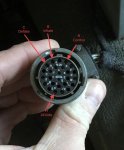- 239
- 505
- 93
- Location
- Portland, OR
Hey all. Has anyone had experience hooking their LMTV to shop air so that they can troubleshoot air issues without the engine running?
I tried hooking up to the front service gladhand, but the system didn’t take much air. I looked at the pneumatic schematic in the TM and I think maybe that’s because I didn’t release the parking brake. Can anyone confirm this?
Also, my shop air is 175 psi. Would this pose a problem for the system or should I regulate it down to 120?
thanks!
I tried hooking up to the front service gladhand, but the system didn’t take much air. I looked at the pneumatic schematic in the TM and I think maybe that’s because I didn’t release the parking brake. Can anyone confirm this?
Also, my shop air is 175 psi. Would this pose a problem for the system or should I regulate it down to 120?
thanks!




